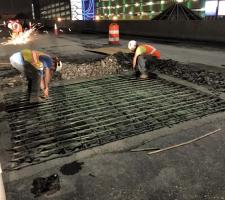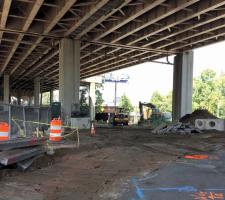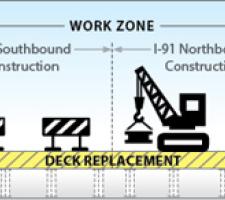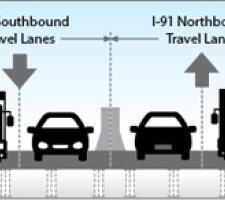
As the deck renewal of the I-91 viaduct in Springfield gets underway, David Crawford looks at the preparation and planning to ease the resulting traffic congestion.
Accommodating the deck renewal of a 4km-long/four-lanes in each direction viaduct in the heart of Springfield (Massachusetts’ third largest city), has involved the state’s Department of Transportation (MassDOT) in a massive exercise in transport research and ITS-based area-wide preplanning and traffic management. Supporting a workzone of well above average scale, this aims to keep traffic flows moving efficiently throughout the reconstruction phase of the US$183.3 million rehab of a key section of Interstate Highway 91 (I-91) that borders the city’s downtown.
The contractor, a joint venture between two companies, J F White Contracting and Schiavone Construction (JV), was awarded the job in May 2015 but only started demolishing the existing reinforced concrete bridge deck, section by section, in February 2016. The intervening period allowed time for preliminary work to accommodate traffic shifts and improve surface streets that were going to be used as diversionary routes.
Two viaduct lanes in both directions will be kept open for the duration. Full traffic use is due to be restored by late autumn 2017 – in an accelerated schedule introduced to minimise the length of disruption, with final contract completion scheduled for February 2019.
Underlining the importance of this schedule, which is underpinned by the traffic management planning and deployment aimed at reducing the risk of hold-ups, the contract contains provision for incentive payments and disincentive deductions of US$50,000 per day for early or late completion. The project is receiving 80% of its funding from the US Department of Transportation’s Federal Highway Administration and 20% from the State.
The viaduct, which opened in 1970, forms part of the 467km-long I-91 main north-south route through the western part of New England, carrying traffic to and from Canada. It also interconnects with other major links in the region, among them the primary east-west interstate corridor between New York and Massachusetts, and copes with an average daily traffic volume of some 75,000 vehicles through the city. Summer and winter weekends generate additional flows.
The viaduct’s elevated deck had been experiencing increasing levels of disrepair with chunks of concrete falling down. Remedial work has involved lane and ramp closures on the bridge deck, with the resulting detours increasing traffic levels on local surface streets - sections of which were also having to be repaired.
Working with the City of Springfield, MassDOT developed a traffic mitigation strategy, including the use of monitoring cameras integrated with the city’s existing system and cover key approach corridors and intersections. In addition, the JV has contracted smart workzone traffic management specialist Asti to install a project-specific real-time traffic management system for the impact area, incorporating warning and changeable message signs along the approaches, lane sensors and highway advisory radio.
Message board signs on interstates leading towards the work zone give motorists estimated times of arrival at an upcoming landmark; for example, northbound drivers will see ‘10 min to I-391’.
The array has been operational since December 2015.
Lane sensors in key areas where traffic queues are anticipated are collecting real-time data for transmission to message boards upstream. The aim is to ensure drivers are prepared for conditions ahead to minimise the risk of rear-end collisions and enabling them to make informed alternative route decisions.
The highway advisory radio is a portable system that will only be used for the lifetime of the project, is a new resource for the state. A spokesperson told ITS International: “Considering the location of the project lying along a key north-south interstate commerce corridor, and adjacent to the primary east-west interstate corridor between New York and Massachusetts, there is significant commercial vehicle traffic that is the target of the system.
“It provides the ability to deliver far more detailed information on the project and associated traffic conditions than traditional changeable message boards.” The broadcasts are accessible at distances of up to 23km from the site.
The entire project-specific real-time traffic management array will be dismantled following completion.
Other major information sources include a dedicated project website which provides detailed detour guidance and invites enrolment for an email alert, while MassDot is also deploying its Twitter and Facebook accounts.
On the overall project, the spokesperson said: “This is the first use of a smart work zone system to provide real-time traffic management within the District 2 [second most westerly] region of the state, so there is no existing experience to build on. However, in other projects where MassDOT has applied aggressive schedule and/or construction methodologies that have allowed us to ‘get in and get out’ on a project, the public has been very receptive.”
The lane sensors have an additional role – of helping to create a historic data archive that will guide decision-making for the region’s future traffic management needs. MassDOT has a current project to build a data warehouse for capturing work zone information; develop a dashboard to send information back to the public; and, ultimately, create a matrix of work zone capacity values based on location-specific lane use needs.
To inform its traffic management planning for this project, MassDOT carried out an extensive online survey in April 2014 on users’ travel patterns – specifically origin/destination, the time they typically travelled on the I-91and other highways or local roads used.
The concept emerged from detailed discussions with the Springfield City Government, the local Chamber of Commerce and the management of the city’s business improvement district which is bounded by the I-91.
The survey, made available in English and Spanish, drew 2,995 responses and showed that 96% of commuters travelled by car alone with 80% using the I-91. More than a third (39%) had a degree of flexibility in their work schedules and 86% parked at their workplaces (of the 318 drivers that did not, 45% indicated that they used the I-91’s own garaging).
In terms of the length of their commutes, 45.4% said between 16 and 30 minutes, 22.2% between 31 and 45 minutes, and 20.2% up to 15 minutes. Around half arrived at work between 7.30 and 8.30am while a slightly lower proportion left to return home between 4.30 and 5.30pm.
The survey went on to ask how locals accessed information about their commute or changes to it.
Many used more than one method; 61.1% citing the general media; 41.3% informal sources such as family, friends or work colleagues; and 29.7% their employer’s intranet or internal website. A further 9.6% cited mobile apps and 6.3% Facebook while only 0.8% used the website of, or alerts from, the regional Pioneer Valley Transit Authority public transport provider.
MassDOT acknowledges that the self-selection and self-reporting inherent in online quizzing can influence the picture that emerges. But its central transportation planning staff expresses confidence that it has gained a “helpful snapshot” of drivers’ travel habits, destinations, flexibility (or lack of it), commute lengths and travel information sources to reference when deploying the temporary traffic management scheme and route diversions.
The resulting information will also be used for making before- and after-project flow analyses, long-term traffic planning and the evaluation of potential investments in alternative transport modes and information sources.
- ABOUT THE AUTHOR: David Crawford has spend 20 years writing about and researching ITS and is a Contributing Editor to ITS International.
















